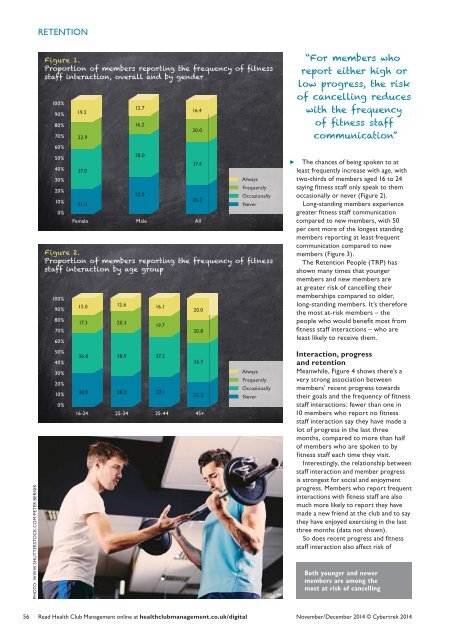DR JOHN MORGAN
Create successful ePaper yourself
Turn your PDF publications into a flip-book with our unique Google optimized e-Paper software.
RETENTION<br />
PHOTO: WWW.SHUTTERSTOCK.COM/PETER BERNIK<br />
Figure 1.<br />
Proportion of members reporting the frequency of fitness<br />
staff interaction, overall and by gender<br />
100%<br />
90%<br />
80%<br />
70%<br />
60%<br />
50%<br />
40%<br />
30%<br />
20%<br />
10%<br />
0%<br />
19.2<br />
22.9<br />
37.0<br />
21.0<br />
12.7<br />
16.2<br />
38.0<br />
33.0<br />
16.4<br />
20.0<br />
37.4<br />
26.2<br />
Female Male All<br />
16-24 25-34 35-44 45+<br />
Always<br />
Frequently<br />
Occasionally<br />
Never<br />
Figure 2.<br />
Proportion of members reporting the frequency of fitness<br />
staff interaction by age group<br />
100%<br />
90%<br />
80%<br />
70%<br />
60%<br />
50%<br />
40%<br />
30%<br />
20%<br />
10%<br />
0%<br />
15.0<br />
17.3<br />
36.8<br />
30.9<br />
12.6<br />
20.3<br />
38.9<br />
28.2<br />
16.1<br />
19.7<br />
37.2<br />
27.1<br />
20.0<br />
20.8<br />
36.7<br />
22.5<br />
Always<br />
Frequently<br />
Occasionally<br />
Never<br />
“For members who<br />
report either high or<br />
low progress, the risk<br />
of cancelling reduces<br />
with the frequency<br />
<br />
communication”<br />
The chances of being spoken to at<br />
least frequently increase with age, with<br />
two-thirds of members aged 16 to 24<br />
saying fi tness staff only speak to them<br />
occasionally or never (Figure 2).<br />
Long-standing members experience<br />
greater fi tness staff communication<br />
compared to new members, with 50<br />
per cent more of the longest standing<br />
members reporting at least frequent<br />
communication compared to new<br />
members (Figure 3).<br />
The Retention People (TRP) has<br />
shown many times that younger<br />
members and new members are<br />
at greater risk of cancelling their<br />
memberships compared to older,<br />
long-standing members. It’s therefore<br />
the most at-risk members – the<br />
people who would benefi t most from<br />
fi tness staff interactions – who are<br />
least likely to receive them.<br />
Interaction, progress<br />
and retention<br />
Meanwhile, Figure 4 shows there’s a<br />
very strong association between<br />
members’ recent progress towards<br />
their goals and the frequency of fitness<br />
staff interactions: fewer than one in<br />
10 members who report no fitness<br />
staff interaction say they have made a<br />
lot of progress in the last three<br />
months, compared to more than half<br />
of members who are spoken to by<br />
fitness staff each time they visit.<br />
Interestingly, the relationship between<br />
staff interaction and member progress<br />
is strongest for social and enjoyment<br />
progress. Members who report frequent<br />
interactions with fi tness staff are also<br />
much more likely to report they have<br />
made a new friend at the club and to say<br />
they have enjoyed exercising in the last<br />
three months (data not shown).<br />
So does recent progress and fi tness<br />
staff interaction also affect risk of<br />
Both younger and newer<br />
members are among the<br />
most at risk of cancelling<br />
56<br />
Read Health Club Management online at healthclubmanagement.co.uk/digital<br />
November/December 2014 © Cybertrek 2014



